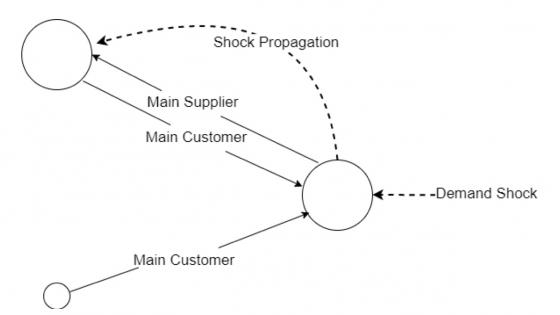Exports are important for economic growth and employment (see, for example, Mayer et al. 2011, Baldwin and Harrigan 2011, Eckel and Neary 2010, and Baldwin and Gu 2009). However, countries do not do trade; it is firms that export and import (Eaton et al 2011, Bernard et al 2011). This basic truth makes it obvious that understanding the firm-level facts is essential to good policymaking in Arab countries. Why exports from some countries grow faster than those from others is one of the most important questions in trade and development economics. Solving this puzzle has the obvious appeal of improving the living standards for a significant proportion of the world population. Our recent work goes further towards answering this question by studying a major determinant of exports growth – product diversification at the exporter-destination level.
Using detailed exporter-level customs transactions data from Jordan1, we find that multi-product exporters in Jordan look remarkably similar to their US and French counterparts, confirming the predictions of recent theoretical models.
We establish four key results for Jordan:
- At the exporter-destination level, exports are driven by a small set of exporters. Specifically, exporters that export to five or more destinations account for only 18.98% of exporters but for 72.32% of export value; and exporters that export to a single destination account for 46.6% of exporters but only for 8.53% of export value.
Table 1. Distribution of exporters and export value by number of products and export destinations, Jordan 2008
In other words, multi-product, multi-destination exporters, in the context of a small developing economy like Jordan, make the bulk of a country’s exports to the rest of the world. This observation is consistent with recent empirical evidence for developed economies (Mayer and Ottaviano 2008, Bernard et al 2007).
- Exporter product diversification causes higher exporter sales at the product level (figure 1).
Figure 1. Product export differentials across exporters at the destination level
We look at the distribution of product sales within each individual geographic market destination. We plot selected products, using HS codes, that are common between various sets of exporter scopes, and we check whether large-scope exporters sell more of the same product at a given geographic market compared to small-scope exporters. We run this simulation across different sets of exporter scopes and products, and the finding holds:
- The impact of distance and size operates through the number of exporters and the number of products more than through the value per product per exporter.
- At the destination level, few exporters are highly diversified at each export market destination and few exporters enter many export market destinations (Figure 2a and 2b).
Figure 2a. Export diversification at the exporter-product-destination level
Figure 2b. Distribution of geographic market entry at the exporter level
Many exporters export few products and few exporters export many products. In Figure 2a, we rank exporters according to their number of products at a given destination. Initially, we consider that the globe is one market destination. Then, in Figure 2b, we look at various destinations, which we select out of the top ten geographic market destinations for Jordanian exporters. The median Jordanian exporter exports two or three products per geographic market destination and the mean number of products is around one to two in individual destinations. This fact is related to the findings of Eaton et al (2011) that, for each destination, there are few large-sale French firms but many small-sale French firms.
Policy implications
While the scope of our study is essentially academic, our findings suggest three important and clear policy implications:
- Raise the number of exporters.
What matters most for a country’s trade performance is, firstly, how many of its firms engage in exporting. Arab governments should focus on policies that broaden the export base. One way to do so is by reducing small (fixed) costs of exporting.
- Do not focus on helping the existing superstars.
If the aim is to broaden the export base, Arab governments should not focus on policies that favour incumbent superstar exporters. Instead, heads of Arab governments should work on lowering barriers to exports at home. Trade missions do not generate trade.
- Support the superstars of the future.
Arab governments should provide the conditions for tomorrow’s export superstars to emerge by allowing small exporters to grow.
Author's note: The author would like to thank Richard Baldwin and Jean Imbs for helpful comments and suggestions.
References
Balassa, B. (1978). “Exports and Economic Growth: Further Evidence,” Journal of Development Economics 5: 181-9.
Baldwin, R. and Gu, W. (2009). “The Impact of Trade on Plant Scale, Production-Run Length and Diversification,” in Producer Dynamics: New Evidence from Micro Data, ed. T Dunne, JB Jensen, MJ Roberts. Chicago: University of Chicago Press.
Baldwin, R. and Harrigan, J. (2011). “Zeros, Quality, and Space: Trade Theory and Trade Evidence," American Economic Journal: Microeconomics 3(2): 60-88.
Bernard, A, Redding, S., and Schott, P. (2011). “Multiproduct Firms and Trade Liberalization," The Quarterly Journal of Economics, Press 126(3), pages 1271-1318.
Bernard, A, Jensen, J.B., Redding, S., and Schott, P. (2007). “Firms in International Trade,” Journal of Economic Perspectives 21(3): 105-130.
Eaton, J., Kortum, S., and Kramarz, F. (2011). “An Anatomy of International Trade: Evidence from French Firms,” Econometrica 79(5): 1453-1498.
Eckel, C., and Neary, J.P. J. (2010). “Multi-Product Firms and Flexible Manufacturing in the Global Economy,” Review of Economic Studies 77(1): 188-217.
Feenstra, R., and Hong, Chang (2010). “China's Exports and Employment,” in NBER Chapters: China's Growing Role in World Trade, pages 167-199, NBER.
Mayer, T., Melitz, M., and Ottaviano, G.I.P. (2011). “Market Size, Competition, and the Product Mix of Exporters,” NBER Working Papers 16959.
Mayer, T., and Ottaviano, G.I.P. (2008). “The Happy Few: The Internationalisation of European Firms,” Intereconomics: Review of European Economic Policy 43(3): 135-148.
1 The dataset covers 1368 exporters in 2004, 1580 exporters in 2005, 1893 exporters in 2006, 1997 exporters in 2007, 2167 exporters in 2008, 2339 exporters in 2009, and 2477 exporters in 2010. The author collected this dataset from Jordan Customs Authority as well as he collected customs datasets from other Middle East and North African countries during his work in summer 2011 under Caroline Freund, the chief economist for MENA Region at the World Bank. The customs data collection effort is part of a larger World Bank project to make customs data available for further analysis and research on exports dynamics and growth. Customs data have been collected from more than 30 countries around the world by a team led by Caroline Freund, and the World Bank will make data available for research purposes. The author got permission from Jordanian and Iranian authorities as well as from Caroline Freund to use data for part of his PhD research work.






